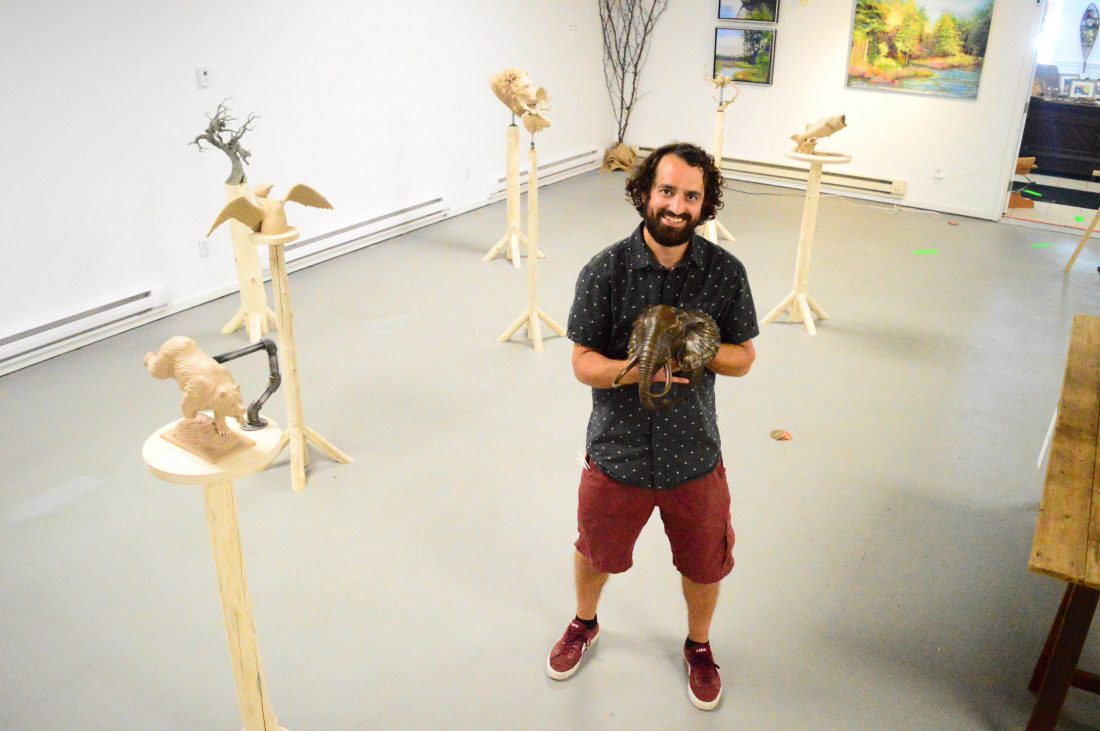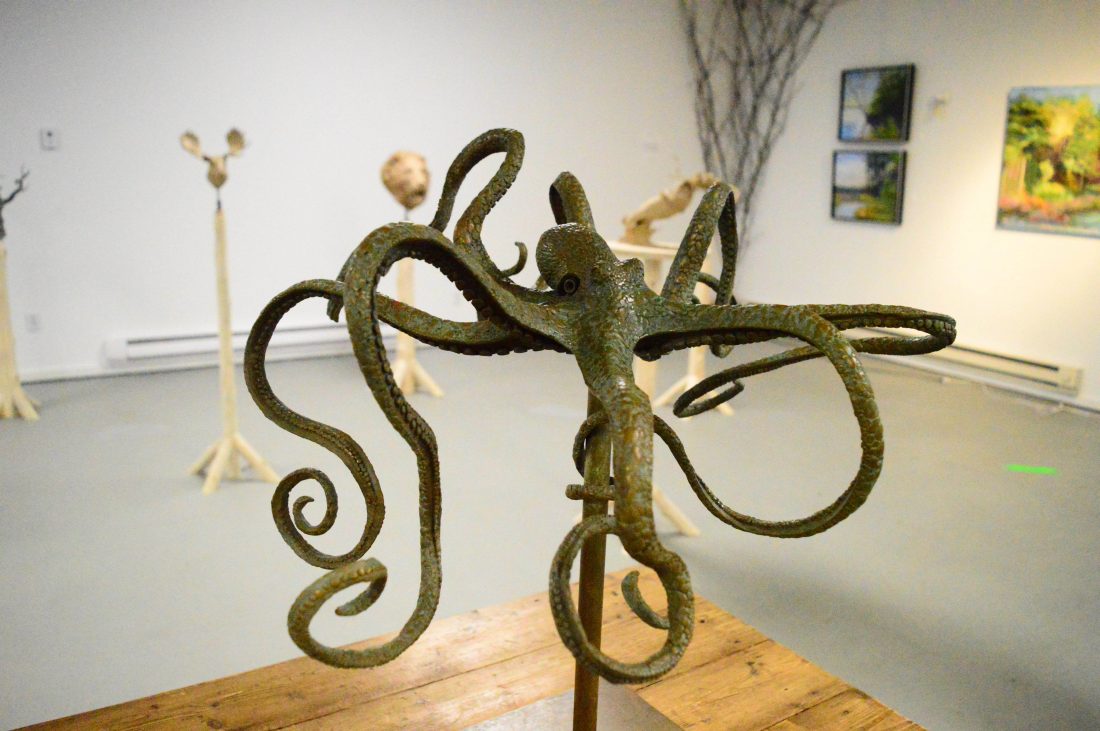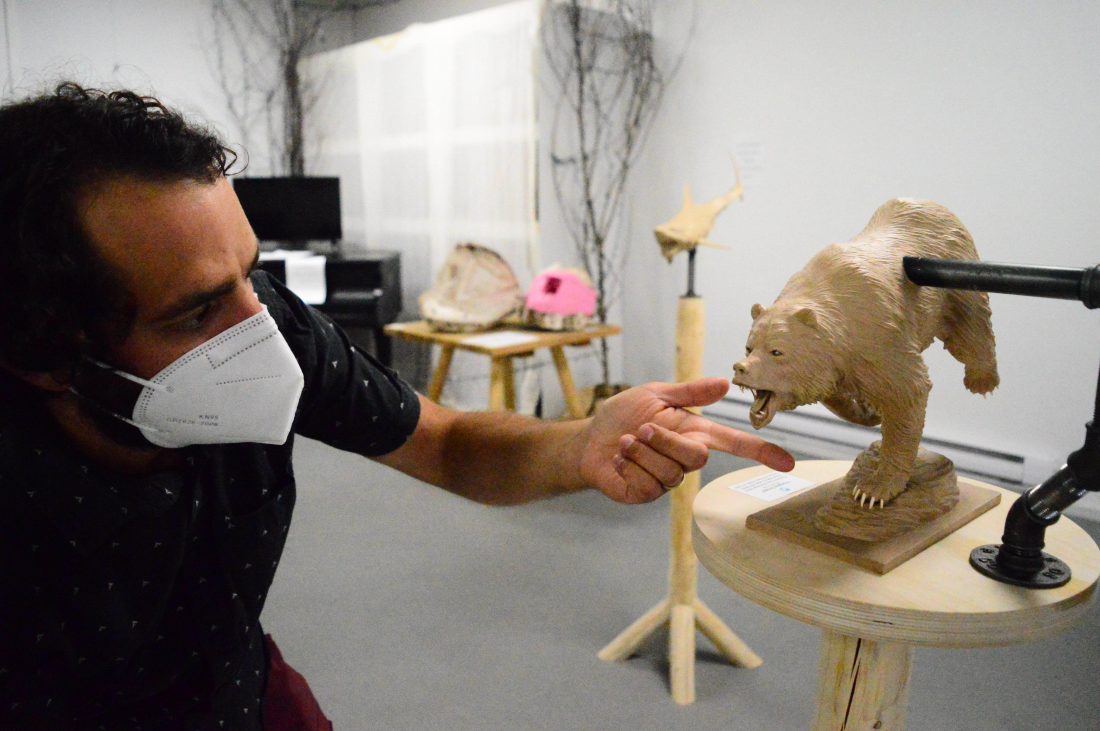Lions and sharks and bears, oh my!

Peter Thomas holds one of his bronze sculptures — an elephant head — amid pillars of his clay sculpture work, now on display at the Tupper Arts gallery. (Enterprise photo — Aaron Cerbone)
TUPPER LAKE — Peter Thomas ran his fingers over his shark’s scarred skin. He wondered about the presumptive years of battles which left the beast pock-marked with wounds.
In reality, these wounds are only a few weeks old. He created them himself in a studio in Brooklyn, carving them out of clay with his homemade tools.
Thomas, 33, stood amid a dozen or so clay animals at his first solo showing of his sculptures, held at Tupper Arts this month. The showing lasts through Sunday.
The shark was still, suspended in air atop thin, wooden bases he carved from ceder found at his family’s camp on Tupper Lake — but it looked alive with motion, lunging after an invisible sea lion.
Thomas is spending the summer in Tupper Lake. Toward the beginning of the COVID-19 pandemic he was barred from working at his Brooklyn studio, so he grabbed his supplies and made his parent’s garage his workshop. When the summer came around he moved here to his family’s camp near the Bog River, where he spends his evenings in his “happy place,” molding and carving animals.

A large bronze octopus seems to reach toward the viewer no matter where they stand. (Enterprise photo — Aaron Cerbone)
Thomas studied graphic design in college, and started with a corporate job in Manhattan. However, he wanted to strike out on his own.
“I was just in front of a computer all day,” Thomas said. “It was missing something.”
He said out of the visual mediums he has worked in — drawing, painting, photography — he found himself drawn to sculpture in his free time. He said he got his start as a kid with Play-Doh and then using Sculpey clay to create action figures when he got older.
Thomas said he likes working in three-dimensional space. A painting is created from one point-of-view, sculptures can be seen from any vantage point.
—

Peter Thomas points out the finer points of a clay grizzly bear sculpture he made. He said he focused on the bear’s muscles and shoulders as it runs. (Enterprise photo — Aaron Cerbone)
Art in motion
—
Thomas’ sculptures have vivid motion, a result of his desire to capture the spirit of each animal he sculpts. A grizzly bear charges, only one paw on the ground, a owl leaps from its perch and an octopus, the largest of his bronze sculptures, thrashes in the water, tentacles swishing and grabbing at the sea.
Even the trees are in motion, branches gnarled by wind, all pointing in one direction.
He started off sculpting static animals, Thomas said, but he “wanted the challenge” of making them move.
Thomas said he chooses to sculpt things he thinks would be nice to feel, focusing on cool textures, poses and the taking notice of the space different animals take up.
“It goes beyond just the physical form of the creature,” Thomas said. “It’s also what they do, their habitat and how intelligent they can be.”
Thomas said he used to make surrealist paintings, which he said came from a dream-like space. These sculptures are more representational. He said they may get more surreal in the future
He is looking to do something unique with his sculptures and said he has been gathering “tools” to make something classical, but with his own personal bent on it.
From 2015 to 2018 Thomas worked with the stone sculptor Barry X Ball, whose work resembles the traditional historical statues which have existed for centuries, but using computers and modern aesthetics to create altered, sometimes disturbing versions of familiar works.
Thomas said he focuses the parts of animals he likes the most — the lion’s mane, the bear’s shoulders the bass’ mouth.
“I tend to emphasize the details that I find most intriguing — not its anatomical accurateness,” Thomas writes in a statement about his show.
Still, he said he spends a lot of time studying the animals to make sure his sculptures are accurate.
He works from the “inside out,” studying the bone structure, the muscles, the tissue, the fat and finally the skin, scales, feathers or fur.
He watches YouTube videos, reads books and looks at hundreds of pictures of these animals to learn about how they move.
The sculptures are not just solid clay, they need an internal armature — made of metal wire, mesh and rods — to stay solid over time. Thomas said the armature acts like a skeletal structure, and as such needs to be anatomically accurate.
—
Meaningful location
—
He said it means a lot doing his first solo showing in Tupper Lake, describing it as an “honor.”
“I’m thankful to Louise (McNally) and Susan (Delehanty) for opening their doors,” Thomas said.
He said solo shows allow for more feedback, and he has heard from dozens of locals and visitors. He said everyone has different pieces they like for different reasons.
Thomas asked a young boy what his favorite piece was and was delighted to see him go study each piece before answering, “I like that moose.”
On Tuesday, Thomas visited the Wild Center and spent hours studying the nature museum’s otters, sketching, taking notes and filming them to inform a future sculpture.
—
A bronze coming of age
—
Thomas said he wants to eventually move into doing more bronze works, but not just anyone can have constant access to a foundry.
“It’s an expensive art form,” Thomas said. “Bronze is not cheap.”
He said if someone buys a bronze piece they want to know it’s from “somebody.” Right now, he said he is a “nobody,” but he hopes to make a name on himself.
The process of turning clay sculptures into bronze ones is long and arduous, bringing the design through many different forms and taking 12 to 16 weeks. Thomas can explain the 10-phase process well, but he said he still has much to learn.
“I want to be that old gray dude, you know, with a big beard, who can say ‘yeah I know how to do that.'”



